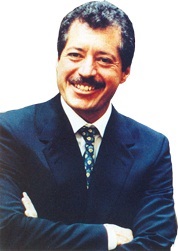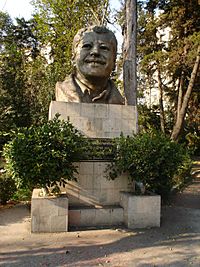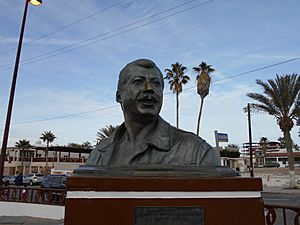Luis Donaldo Colosio Murrieta facts for kids
Quick facts for kids
Luis Donaldo Colosio Murrieta
|
|
|---|---|
 |
|
| Secretary of Social Development of Mexico | |
| In office 8 April 1992 – 28 November 1993 |
|
| President | Carlos Salinas de Gortari |
| Preceded by | Patricio Chirinos Calero |
| Succeeded by | Carlos Rojas Gutiérrez |
| President of the Institutional Revolutionary Party | |
| In office 3 September 1988 – 13 April 1992 |
|
| Preceded by | Jorge de la Vega Domínguez |
| Succeeded by | Rafael Rodríguez Barrera |
| Senator of the Congress of the Union for Sonora |
|
| In office 1 September 1988 – 2 December 1988 |
|
| Preceded by | Fernando Mendoza Contreras |
| Succeeded by | Armando Hopkins Durazo |
| Member of the Congress of the Union for the 6th district of Sonora |
|
| In office 1 September 1985 – 31 August 1988 |
|
| Preceded by | Rubén Castro Ojeda |
| Succeeded by | Sergio Jesús Torres Serrano |
| Personal details | |
| Born | 10 February 1950 Magdalena de Kino, Sonora, Mexico |
| Died | 23 March 1994 (aged 44) Tijuana, Baja California, Mexico |
| Resting place | Municipal Cemetery Magdalena de Kino, Sonora, Mexico |
| Political party | |
| Spouse |
Diana Laura Riojas
(m. 1982) |
| Children | Luis Donaldo Colosio Riojas Mariana Colosio |
| Parents | Luis Colosio Fernández Ofelia Murrieta Armida García |
| Occupation | Politician, economist |
Luis Donaldo Colosio Murrieta (born February 10, 1950 – died March 23, 1994) was an important Mexican politician and economist. He was a candidate for president of Mexico with the Institutional Revolutionary Party (PRI). Sadly, he was assassinated during his campaign in 1994.
Contents
Who Was Luis Donaldo Colosio?
Luis Donaldo Colosio was born in Magdalena de Kino, Sonora, Mexico. His family had a long history in politics. He studied economics at the ITESM, a well-known university in Mexico.
After finishing his studies, he joined the Institutional Revolutionary Party (PRI) in 1972. This party was very powerful in Mexico for many years. Colosio also continued his studies in the United States and Austria. In 1979, he started working in the government with Carlos Salinas de Gortari, who would later become president.
Colosio's Early Political Career
Colosio was elected to the Mexican Congress in 1985. He represented his hometown. In 1987, he joined the main committee of the PRI party.
When Carlos Salinas ran for president in 1988, he chose Colosio to manage his campaign. In the same election, Colosio was also elected to the Senate, representing his home state of Sonora.
During the early years of Salinas's presidency, Colosio led the PRI party as its chairman. In 1992, President Salinas appointed him to a new government position: Secretary of Social Development. This role focused on improving social programs for people in Mexico.
Running for President
In 1994, Luis Donaldo Colosio became the PRI's candidate for president. At first, his campaign was a bit slow. Many people were paying attention to another politician, Manuel Camacho Solís, who was dealing with a rebel group called the EZLN.
However, Colosio soon started to get strong support from the PRI party. He was greeted by large crowds during his campaign, just like previous PRI candidates. Even though the party was not as popular as it used to be, many people still came to see him.
Important Speech in March 1994
On March 6, 1994, Colosio gave a very important speech in Mexico City. He spoke in front of the Monument to the Mexican Revolution. In his speech, he talked about important issues like the needs of indigenous communities and the importance of people being independent from the government.
These topics were very relevant because the Zapatista rebels were also talking about similar ideas. Many people believe this speech showed that Colosio was starting to have different ideas from President Salinas.
Who Was the Real Candidate?
In Mexico, presidents can only serve one term. For a long time, the president would secretly choose who would be the next presidential candidate for their party. This changed later, but at the time, President Salinas was expected to pick his successor.
There were rumors that Manuel Camacho might replace Colosio as the candidate because Colosio's campaign was struggling. President Salinas tried to stop these rumors by saying, "Don't get confused: Colosio is the candidate."
Camacho eventually said he would not run for president and would focus on the conflict in Chiapas instead. The very next day after Camacho's statement, Luis Donaldo Colosio was killed.
Colosio's Assassination

On March 23, 1994, at about 5:05 PM, Luis Donaldo Colosio was at a campaign rally. This rally was in Lomas Taurinas, a poor neighborhood in Tijuana, Baja California. During the event, he was shot.
Colosio fell down and was quickly taken to the main hospital in the city. Plans to fly him to a hospital in the United States were canceled. A few hours later, his death was announced. There were different stories from people who saw what happened, and these differences still exist today.
The person who shot him, Mario Aburto Martínez, was arrested right there. He always said that he acted alone. However, many different ideas and theories about Colosio's assassination still remain.
On November 18, 1994, Diana Laura Riojas, Colosio's wife, passed away. Officially, her death was due to pancreatic cancer. She had been investigating her husband's murder. The new president, Ernesto Zedillo, did not attend her funeral.
See also
 In Spanish: Luis Donaldo Colosio para niños
In Spanish: Luis Donaldo Colosio para niños


